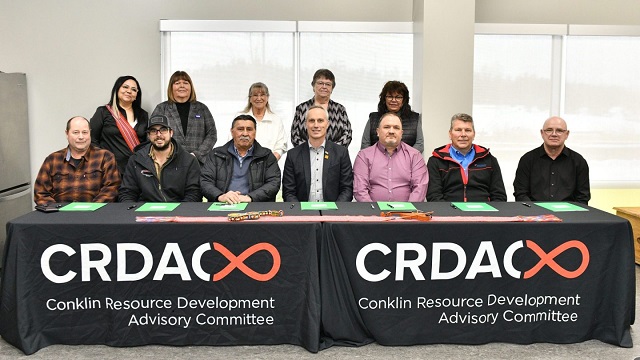Alberta
Northern Alberta Métis community launches seven new oil sands partnerships to boost economic opportunity

L-R (seated): Great Northern Bridgeworks president Steve Ross, Enviromulch Mulching & Logging superintendent Phil Mamers, Lynco Energy Services owner Doug Golosky, Surerus Murphy Joint Venture chairman Sean Surerus, Brothers HDD owner Jamie McClennon, Gateway Mechanical Services account executive Dean Seiz, Dorval O & M Services owner Brent Dorval (sitting in for Global Fusion Coating general manager Chad Olsen). L-R (standing): CRDAC directors Stacey Atkinson, Valerie Quintal, Shirley Tremblay, Margaret Quintal, and Grace Richards. Photo courtesy CRDAC
From the Canadian Energy Centre
About 150 kilometres south of Fort McMurray, the Conklin region is responsible for nearly 1/3 of oil sands production
The predominantly Métis community of Conklin has launched seven new business partnerships in a bid to lift its opportunities in one of Alberta’s busiest oil sands regions.
From drilling to heavy machinery and pipelines, the new ventures will bring an economic and social boost to the community of 300 residents about 150 kilometres southeast of Fort McMurray.
“We’d like to focus more on getting local opportunities such as training, employment, maybe some subcontracting, to build the local businesses up and build our people up for local employment,” said Valerie Quintal, president of Conklin Métis Local 193.
“We are going to be planning with each one of them how we could better serve our community members.”
Quintal is also a director of the Conklin Resource Development Advisory Committee (CRDAC), which brokered the deals with companies including Brothers HDD, Gateway Mechanical Services and Surerus-Murphy Joint Venture.
CRDAC was established in 2008 to help the community engage with growing oil sands development in the Conklin region, said CEO Scott Duguid.
The area has become a hub for development using a technology called steam assisted gravity drainage (SAGD), which involves drilling horizontal well pairs and steam injection to produce oil sands crude.
“It was really developed when a lot of the SAGD development was in the application or the environment assessment phase and there was a huge push for regulatory consultation and engagement with government on regulatory applications for SAGD,” he said.

Métis cultural heritage is displayed alongside a map of development activity in the Conklin region. Photo courtesy CRDAC
The area around Conklin is now home to six major oil sands projects owned by the industry’s biggest producers. This includes Cenovus Energy’s Christina Lake facility, the largest so-called “in situ” project in the oil sands.
As of January 2024, the region produced more than 550,000 barrels per day, or nearly one-third of all oil sands production, according to the Alberta Energy Regulator.
CRDAC has partnerships in place with the big players in the region including Cenovus, Canadian Natural Resources and MEG Energy, Duguid said (including a unique home construction program with Cenovus).
But the new ventures take opportunity to the next layer, with companies that service or work for oil sands producers, he said.
Duguid said the group has partnerships in place with the big players in the region such as Cenovus, MEG, CNRL, and Harvest.
“There’s a fair amount of wealth being generated in the region and out of the South Athabasca oilsands. There’s a lot of work happening,” said Duguid.
“We as sort of a community representative organization are trying to put our hands up with some of these smaller industry players and saying ‘hey, we’re here, we have community members, we have a potential workforce, we may need training, we may need some capacity to ensure that our residents can be meaningfully employed, but we can work with you and for you.’”
The hope is that partnering with these mid-level businesses will provide an opportunity for grassroots Conklin businesses to grow, he said.
Some of the revenue from the partnerships will come back to the community to support social programs such as healthcare, housing, and substance abuse treatment.
“It’s hugely significant for the community,” Duguid said.
Gateway Mechanical Services’ Dean Seiz said the company reached out to CRDAC last year to see if they would be interested in a working relationship.
“Basically, the long-term goal is to see if there are any community members that would be interested in maybe getting into the trades that Gateway does,” Seiz said.
The company, with its head office in Edmonton, provides heating, ventilation and air conditioning (HVAC), plumbing and refrigeration services across Western Canada. It has nine locations for regional offices with about 275 technicians.
“It’s a work in progress with Scott [Duguid] and the community to see what’s important to the community to make things work,” Seiz said.
Alberta
CPP another example of Albertans’ outsized contribution to Canada

From the Fraser Institute
By Tegan Hill
Amid the economic uncertainty fuelled by Trump’s trade war, its perhaps more important than ever to understand Alberta’s crucial role in the federation and its outsized contribution to programs such as the Canada Pension Plan (CPP).
From 1981 to 2022, Albertan’s net contribution to the CPP—meaning the amount Albertans paid into the program over and above what retirees in Alberta received in CPP payments—was $53.6 billion. In 2022 (the latest year of available data), Albertans’ net contribution to the CPP was $3.0 billion.
During that same period (1981 to 2022), British Columbia was the only other province where residents paid more into the CPP than retirees received in benefits—and Alberta’s contribution was six times greater than B.C.’s contribution. Put differently, residents in seven out of the nine provinces that participate in the CPP (Quebec has its own plan) receive more back in benefits than they contribute to the program.
Albertans pay an outsized contribution to federal and national programs, including the CPP because of the province’s relatively high rates of employment, higher average incomes and younger population (i.e. more workers pay into the CPP and less retirees take from it).
Put simply, Albertan workers have been helping fund the retirement of Canadians from coast to coast for decades, and without Alberta, the CPP would look much different.
How different?
If Alberta withdrew from the CPP and established its own standalone provincial pension plan, Alberta workers would receive the same retirement benefits but at a lower cost (i.e. lower CPP contribution rate deducted from our paycheques) than other Canadians, while the contribution rate—essentially the CPP tax rate—to fund the program would likely need to increase for the rest of the country to maintain the same benefits.
And given current demographic projections, immigration patterns and Alberta’s long history of leading the provinces in economic growth, Albertan workers will likely continue to pay more into the CPP than Albertan retirees get back from it.
Therefore, considering Alberta’s crucial role in national programs, the next federal government—whoever that may be—should undo and prevent policies that negatively impact the province and Albertans ability to contribute to Canada. Think of Bill C-69 (which imposes complex, uncertain and onerous review requirements on major energy projects), Bill C-48 (which bans large oil tankers off B.C.’s northern coast and limits access to Asian markets), an arbitrary cap on oil and gas emissions, numerous other “net-zero” targets, and so on.
Canada faces serious economic challenges, including a trade war with the United States. In times like this, it’s important to remember Alberta’s crucial role in the federation and the outsized contributions of Alberta workers to the wellbeing of Canadians across the country.
Alberta
Made in Alberta! Province makes it easier to support local products with Buy Local program

Show your Alberta side. Buy Local. |
When the going gets tough, Albertans stick together. That’s why Alberta’s government is launching a new campaign to benefit hard-working Albertans.
Global uncertainty is threatening the livelihoods of hard-working Alberta farmers, ranchers, processors and their families. The ‘Buy Local’ campaign, recently launched by Alberta’s government, encourages consumers to eat, drink and buy local to show our unified support for the province’s agriculture and food industry.
The government’s ‘Buy Local’ campaign encourages consumers to buy products from Alberta’s hard-working farmers, ranchers and food processors that produce safe, nutritious food for Albertans, Canadians and the world.
“It’s time to let these hard-working Albertans know we have their back. Now, more than ever, we need to shop local and buy made-in-Alberta products. The next time you are grocery shopping or go out for dinner or a drink with your friends or family, support local to demonstrate your Alberta pride. We are pleased tariffs don’t impact the ag industry right now and will keep advocating for our ag industry.”
Alberta’s government supports consumer choice. We are providing tools to help folks easily identify Alberta- and Canadian-made foods and products. Choosing local products keeps Albertans’ hard-earned dollars in our province. Whether it is farm-fresh vegetables, potatoes, honey, craft beer, frozen food or our world-renowned beef, Alberta has an abundance of fresh foods produced right on our doorstep.
Quick facts
- This summer, Albertans can support local at more than 150 farmers’ markets across the province and meet the folks who make, bake and grow our food.
- In March 2023, the Alberta government launched the ‘Made in Alberta’ voluntary food and beverage labelling program to support local agriculture and food sectors.
- Through direct connections with processors, the program has created the momentum to continue expanding consumer awareness about the ‘Made in Alberta’ label to help shoppers quickly identify foods and beverages produced in our province.
- Made in Alberta product catalogue website
Related information
-

 International2 days ago
International2 days agoPope Francis Dies on Day after Easter
-

 International2 days ago
International2 days agoJD Vance was one of the last people to meet Pope Francis
-

 2025 Federal Election1 day ago
2025 Federal Election1 day agoOttawa Confirms China interfering with 2025 federal election: Beijing Seeks to Block Joe Tay’s Election
-

 2025 Federal Election1 day ago
2025 Federal Election1 day agoHow Canada’s Mainstream Media Lost the Public Trust
-

 2025 Federal Election24 hours ago
2025 Federal Election24 hours agoBREAKING: THE FEDERAL BRIEF THAT SHOULD SINK CARNEY
-

 COVID-191 day ago
COVID-191 day agoNearly Half of “COVID-19 Deaths” Were Not Due to COVID-19 – Scientific Reports Journal
-

 2025 Federal Election1 day ago
2025 Federal Election1 day agoPOLL: Canadians want spending cuts
-

 John Stossel1 day ago
John Stossel1 day agoClimate Change Myths Part 2: Wildfires, Drought, Rising Sea Level, and Coral Reefs






